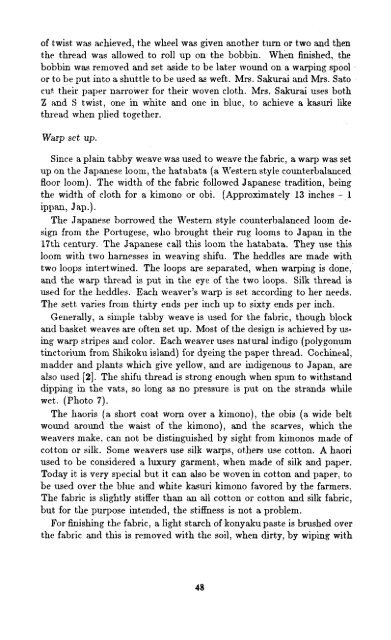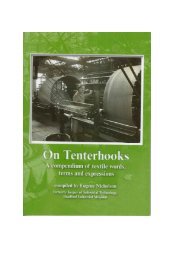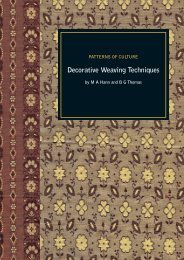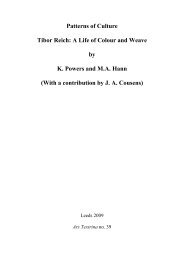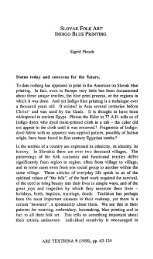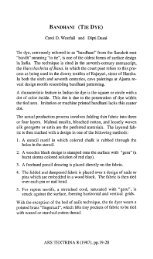shifu: a handwoven paper textile of japan - International Textiles ...
shifu: a handwoven paper textile of japan - International Textiles ...
shifu: a handwoven paper textile of japan - International Textiles ...
Create successful ePaper yourself
Turn your PDF publications into a flip-book with our unique Google optimized e-Paper software.
<strong>of</strong> twist was achieved, the wheel was given another turn or two and then<br />
the thread was allowed to roll up on the bobbin. When finished, the<br />
bobbin was removed and set aside to be later wound on a warping spool<br />
or to be put into a shuttle to be used as weft. Mrs. Sakurai and Mrs. Sato<br />
cut their <strong>paper</strong> narrower for their woven cloth. Mrs. Sakurai uses both<br />
Z and S twist, one in white and one in blue, to achieve a kasuri like<br />
thread when plied together.<br />
Warp set up.<br />
Since a plain tabby weave was used to weave the fabric, a warp was set<br />
up on the Japanese loom, the hatabata (a Western style counterbalanced<br />
floor loom). The width <strong>of</strong> the fabric followed Japanese tradition, being<br />
the width <strong>of</strong> cloth for a kimono or obi. (Approximately 13 inches - 1<br />
ippan, Jap.).<br />
The Japanese borrowed the Western style counterbalanced loom de<br />
sign from the Portugese, who brought their rug looms to Japan in the<br />
17th century. The Japanese call this loom the hatabata. They use this<br />
loom with two harnesses in weaving <strong>shifu</strong>. The heddles are made with<br />
two loops intertwined. The loops are separated, when warping is done,<br />
and the warp thread is put in the eye <strong>of</strong> the two loops. Silk thread is<br />
used for the heddles. Each weaver's warp is set according to her needs.<br />
The sett varies from thirty ends per inch up to sixty ends per inch.<br />
Generally, a simple tabby weave is used for the fabric, though block<br />
and basket weaves are <strong>of</strong>ten set up. Most <strong>of</strong> the design is achieved by us<br />
ing warp stripes and color. Each weaver uses natural indigo (polygonum<br />
tinctorium from Shikoku island) for dyeing the <strong>paper</strong> thread. Cochineal,<br />
madder and plants which give yellow, and are indigenous to Japan, are<br />
also used [2]. The <strong>shifu</strong> thread is strong enough when spun to withstand<br />
dipping in the vats, so long as no pressure is put on the strands while<br />
wet. (Photo 7).<br />
The haoris (a short coat worn over a kimono), the obis (a wide belt<br />
wound around the waist <strong>of</strong> the kimono), and the scarves, which the<br />
weavers make, can not be distinguished by sight from kimonos made <strong>of</strong><br />
cotton or silk. Some weavers use silk warps, others use cotton. A haori<br />
used to be considered a luxury garment, when made <strong>of</strong> silk and <strong>paper</strong>.<br />
Today it is very special but it can also be woven in cotton and <strong>paper</strong>, to<br />
be used over the blue and white kasuri kimono favored by the farmers.<br />
The fabric is slightly stiffer than an all cotton or cotton and silk fabric,<br />
but for the purpose intended, the stiffness is not a problem.<br />
For finishing the fabric, a light starch <strong>of</strong> konyaku paste is brushed over<br />
the fabric and this is removed with the soil, when dirty, by wiping with<br />
48


